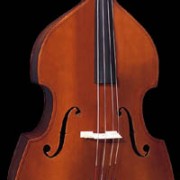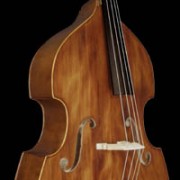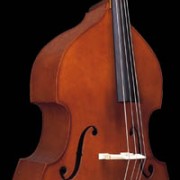Double Bases – Student and Professional – Vienna
Available colours: chesnut/brown, reddish/brown, gold/brown, gold/reddish brown, blueburst, sunburst, blond, brushed and washed finish.
Intermediate Basses – hand-carved top of solid spruce; laminated maple or aningre (roundback/arched) back; maple neck; inlaid purflings (hand-shaded); spirit or polyurethane varnish; ebony fittings; 4 machine heads (nickel plated). Available in 4/4 – 1/8 sized.
Advanced Basses – hand-carved top of solid spruce; laminated quilted or flamed maple or aningre back (roundback/arched); maple neck; inlaid purflings (hand-shaded); spirit or polyurethane varnish, ebony fittings; 4 machine heads (nickel-plated). Available in 4/4 – 1/8 sizes.
Semi Professional Basses – hand-carved solid spruce top; solid, hand-carved slightly-flamed maple back (flat – “Da Gamba” sytle) and sides; maple neck; inlaid purflings, spirit varnish; 4 machine heads (nickel-plated). Available in 4/4 – 1/4 or 4/4 – 3/4 sizes.
Professional Basses – loft-seasoned solid spruce top and maple back, neck and sides — all hand-carved; inlaid purflings, roundback (arched) back; spirit or polyurethane varnish; ebony fittings; 4 machine heads (nickel-plated). Available in 3/4 sizes only.
HYBRID (SOLID TOP/LAMINATED BACK) BASSES. If a fully-carved bass if out of your price range, but you want some of the advantages of the carved bass sound, a hybrid bass is the way to go. These basses are ideal for student or non-professional classical playing; they are also perfect for jazz and and all other styles of playing.
FULLY-CARVED BASSES. If you can afford a fully-carved bass, and do not object to the added maintenance and care, consider a carved bass. Fully-carved basses tend to be louder, richer and deeper in tone, with a sound that is more “mature” overall. The higher partials are richer, giving the tone more clarity. The lows tend to be clearer, fuller and louder. The highs are more focused and project better. Sounds produced by the bow sound much better than on other types of basses. At the same time, pizzicato playing will be clearer and have greater sustain. If you are focused on playing classical music, a good carved bass is important. Nevertheless, one can certainly get a long way on a laminate or hybrid if it is set up properly. A good carved bass will sound excellent in just about any musical situation.
FLATBACK vs. ROUNDBACK (ARCHED) BASSES. There are two methods of back construction for fully-carved basses: flatback and roundback. Roundback construction is similar to the top: it is carved using an arched shape out of solid wood. Flatbacks are made from thin sheets of solid wood, glued on the edges and reinforced on the inside with 4-6 braces that usually run perpendicular to the grain of the back. The braces keep the large flat surface of the flatback from warping and buckling, and give the back more strength. Roundbacks, because of their arched shape and harder wood construction, almost never crack; flatbacks almost always do. The braces on flatbooks prevent the wood from expanding and contracting; eventually the back breaks free from the braces or cracks, or both. This is not to say flatback basses are inferior; indeed, some of the finest old and new instruments use flatback construction. However, they are less stable than roundbacks. New flatbacks are especially prone to problems as the wood settles and adjusts.
Audio or video clips, as well as more photos available upon request.
All prices including tax, but without insurance and shipping costs.





